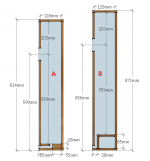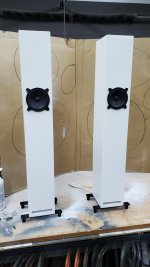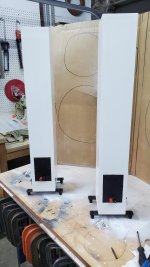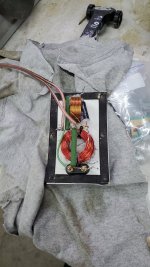Yes I did as long as it's not a high aspect ratio (or should have), but also said NO earlier today with link since from dim memory the Tabaq has a full width shelf vent, which when made round won't have the same end correction, hence pipe length.
Thanks, GM.
How much difference would the slot vent be from a round flared vent?
Would it be significant, or the room interactions around the ported frequency would make it irrelevant?
How much difference would the slot vent be from a round flared vent?
Would it be significant, or the room interactions around the ported frequency would make it irrelevant?
You're welcome!
Dunno about slot versus flared; the only flared I ever used was the pioneer's poor man's 1/8th WL mini BLH slant board slot vent and frankly surprised I haven't seen any from the 'Asian persuasion' folks, what with all ya'll's various complex BRs, BP6, etc., BLHs.
Regardless, IME once tuning drops below 40-45 Hz, the actual tuning can be pretty far off and nobody notices. For instance I more often than not had to individually tune stereo pairs due to the limited/desired locations to the point where one might as well been sealed and nobody ever commented, though of course they either weren't around and/or (somewhat) mellowed out enough for one reason or another to pay any attention.
In short, down low it's always about the room IME. but never actually did any bookshelf/table mounted speakers, which I assume would be easier to notice a few Hz. Around here at the time, 4-5 ft^3 was a 'bookshelf' speaker due to driver specs, low power, low DF/matching impedance amps.
Dunno about slot versus flared; the only flared I ever used was the pioneer's poor man's 1/8th WL mini BLH slant board slot vent and frankly surprised I haven't seen any from the 'Asian persuasion' folks, what with all ya'll's various complex BRs, BP6, etc., BLHs.
Regardless, IME once tuning drops below 40-45 Hz, the actual tuning can be pretty far off and nobody notices. For instance I more often than not had to individually tune stereo pairs due to the limited/desired locations to the point where one might as well been sealed and nobody ever commented, though of course they either weren't around and/or (somewhat) mellowed out enough for one reason or another to pay any attention.
In short, down low it's always about the room IME. but never actually did any bookshelf/table mounted speakers, which I assume would be easier to notice a few Hz. Around here at the time, 4-5 ft^3 was a 'bookshelf' speaker due to driver specs, low power, low DF/matching impedance amps.
Thanks for replays.
Twocents, sorry for being unclear, didn't mean any W3, but any of the W3 that is mentioned in twocents excellent guide 🙂
GM, so I suspected. So a minor correction of the length might be necessary. I'm guessing it shouldn't be more that ±1cm? Still on sketching, so I will not go deeper now, as long as I know it doable (and I also might end up with slot vent).
Twocents, sorry for being unclear, didn't mean any W3, but any of the W3 that is mentioned in twocents excellent guide 🙂
GM, so I suspected. So a minor correction of the length might be necessary. I'm guessing it shouldn't be more that ±1cm? Still on sketching, so I will not go deeper now, as long as I know it doable (and I also might end up with slot vent).
You're welcome!
Well, it depends in that I'm assuming that your round vent will be far enough away from a solid wall to only have a 0.732 end correction (the standard one used in software) whereas the slot will = 2.227, so assuming 10 cm dia pipe = 5 cm radius*0.732 = 3.66 cm shorter Vs the 2.227's 11.14 cm, so could be pretty significant in that as long as some of the Tabaq's slot vents are, the pipe might need to be folded or at least slanted up.
Speaking of which, I mentioned slanted vents way back when on the long gone basslist that cutting both ends of a vent pipe at an angle and mounted angled up was IME the best overall way since the terminus was down low for boundary gain with the other end up by the driver for the pioneer's max loading 'driver in vent' layout plus the slant was a flare of sorts, but can't remember anyone actually trying it, guessing either the slant hole through the box and/or the need to tune it empirically wasn't worth the effort.
Well, it depends in that I'm assuming that your round vent will be far enough away from a solid wall to only have a 0.732 end correction (the standard one used in software) whereas the slot will = 2.227, so assuming 10 cm dia pipe = 5 cm radius*0.732 = 3.66 cm shorter Vs the 2.227's 11.14 cm, so could be pretty significant in that as long as some of the Tabaq's slot vents are, the pipe might need to be folded or at least slanted up.
Speaking of which, I mentioned slanted vents way back when on the long gone basslist that cutting both ends of a vent pipe at an angle and mounted angled up was IME the best overall way since the terminus was down low for boundary gain with the other end up by the driver for the pioneer's max loading 'driver in vent' layout plus the slant was a flare of sorts, but can't remember anyone actually trying it, guessing either the slant hole through the box and/or the need to tune it empirically wasn't worth the effort.
Round ports are fine and Bjorn also used a roundish port for the commercial Tabaq speakers. Use the search function to give all the posts with "round" and you will find posts where it has been done.Is it OK to change the shape of the port? Keeping length and area, but make it round?
See posts #2265, 2266, 3013 for example.
Thanks! I knew it must have been debated before. Thanks for you patience 🙂
I also saw that I have been writing here about two years ago. Hopefully this time I come around and actually build a speaker!
I also saw that I have been writing here about two years ago. Hopefully this time I come around and actually build a speaker!
I also read this (#2994, I have marked the bold part). My idea have been to use some cnc magic to create a nice bended line. I have read that 45 degree corners isn't recommended, but I thought that a smooth radial bend must be better than a straight corner, but not used because of difficulty to make. Am I wrong then? Should I just go for straight corner I the line's bends?You've had your answers, me, I'll just add a couple of things....
Don't put 45 deg corners along the line. It looks cute, and it seems a good idea when you look at it, but the only thing it helps is getting the higher frequencies out the port... which is something you definitively don't want.
Keep the corners square... it will help kill those unwanted frequencies.
The other thing with your design is a visual one.. well, at least for me.
The driver will be weirdly placed on that front baffle, and the OCD side of my personality would find that aggravating! 🙂
The way luigiman designed his folding appeals to that side of my personality better! 🙂
GM, the 3" TABAQs are usually port tuned at about 55Hz, a little lower for the 4".
The slot vent area is 16cm^3 and 9cm long.
q77, nope, even thought in our minds, we can "see" the waves travelling along more easily with 45 or rounded corners, those are the unwanted frequencies.
The lower ones will have no problem with square corners, but the higher ones, being shorter, will get bounced back and lost. Adding fluffy material will help kill those high frequencies, and square corners will also help. You do not want higher frequencies coming out of the port since they will interact with the driver's frequencies towards our listening position.
The slot vent area is 16cm^3 and 9cm long.
q77, nope, even thought in our minds, we can "see" the waves travelling along more easily with 45 or rounded corners, those are the unwanted frequencies.
The lower ones will have no problem with square corners, but the higher ones, being shorter, will get bounced back and lost. Adding fluffy material will help kill those high frequencies, and square corners will also help. You do not want higher frequencies coming out of the port since they will interact with the driver's frequencies towards our listening position.
Interesting. Does this also mean that the number of corners/bends has a small impact on the performance?
Hello, did anyone manage to put a small (class-d) amp inside the Tabaq cabinet?
(I know there are amp sections, but i am interestes in this particular build.)
Thanks
(I know there are amp sections, but i am interestes in this particular build.)
Thanks
Shouldn't be a problem. You could get two small mono amps, but that would also means two power cords, one for each cabinet.Hello, did anyone manage to put a small (class-d) amp inside the Tabaq cabinet?
(I know there are amp sections, but i am interestes in this particular build.)
Thanks
Or place a stereo amp in one cabinet and you would only need one cable going to the second cabinet.
As you'd prefer.
I'd avoid placing the small amp boards on the "roof" of TABAQs. That's where there's the biggest build up of pressure. You better stick in on a wall, between the driver and the vent.
I've actually been pondering making a pair of TABAQs into a TWS Bluetooth pair for some time. I've been searching for a pair of amp boards with built in TWS Bluetooth, and also a possible battery power option to match. How cool would that be?
Sounds cool if you are into bluetooth.I've actually been pondering making a pair of TABAQs into a TWS Bluetooth pair for some time. I've been searching for a pair of amp boards with built in TWS Bluetooth, and also a possible battery power option to match. How cool would that be?
There are small class-d amp modules with bt connection, although I do not know what TWS stands for.
I am more towards wired quality. Battery power is something beyond this for me, the cabinet is too heavy to be portable.
My main goal is to make it compact and remove the Hifi-desk look.
Great idea for active speakers. TWS = True Wireless Stereo. See X’s thread on how to implement this:I've actually been pondering making a pair of TABAQs into a TWS Bluetooth pair for some time. I've been searching for a pair of amp boards with built in TWS Bluetooth, and also a possible battery power option to match. How cool would that be?
https://www.diyaudio.com/community/threads/true-wireless-stereo-tws-bluetooth-for-speakers.379643/
Also, if one use Plan B there is some unused space for a Class D amp.
Attachments
If I knew how to design this in a way to run 2 4FE35s in a parallel 1.5 way config, these would really be incredible. An extra 6db of headroom would make these work in just about any room.
You could.
You have to double the cross-section area, keeping the height and the vent the same.
Put the drivers so that the center between them is the center of a single driver.
Put an inductor to cut off the higher end of the lower driver , you'd probably not need a BSC filter anymore.
You could use XSim to find the best value of the inductor, probably something around 1mH or bigger, for a first order, or something steeper if the interactions between the two drivers are too much.
You have to double the cross-section area, keeping the height and the vent the same.
Put the drivers so that the center between them is the center of a single driver.
Put an inductor to cut off the higher end of the lower driver , you'd probably not need a BSC filter anymore.
You could use XSim to find the best value of the inductor, probably something around 1mH or bigger, for a first order, or something steeper if the interactions between the two drivers are too much.
- Home
- Loudspeakers
- Full Range
- TABAQ TL for Tangband



